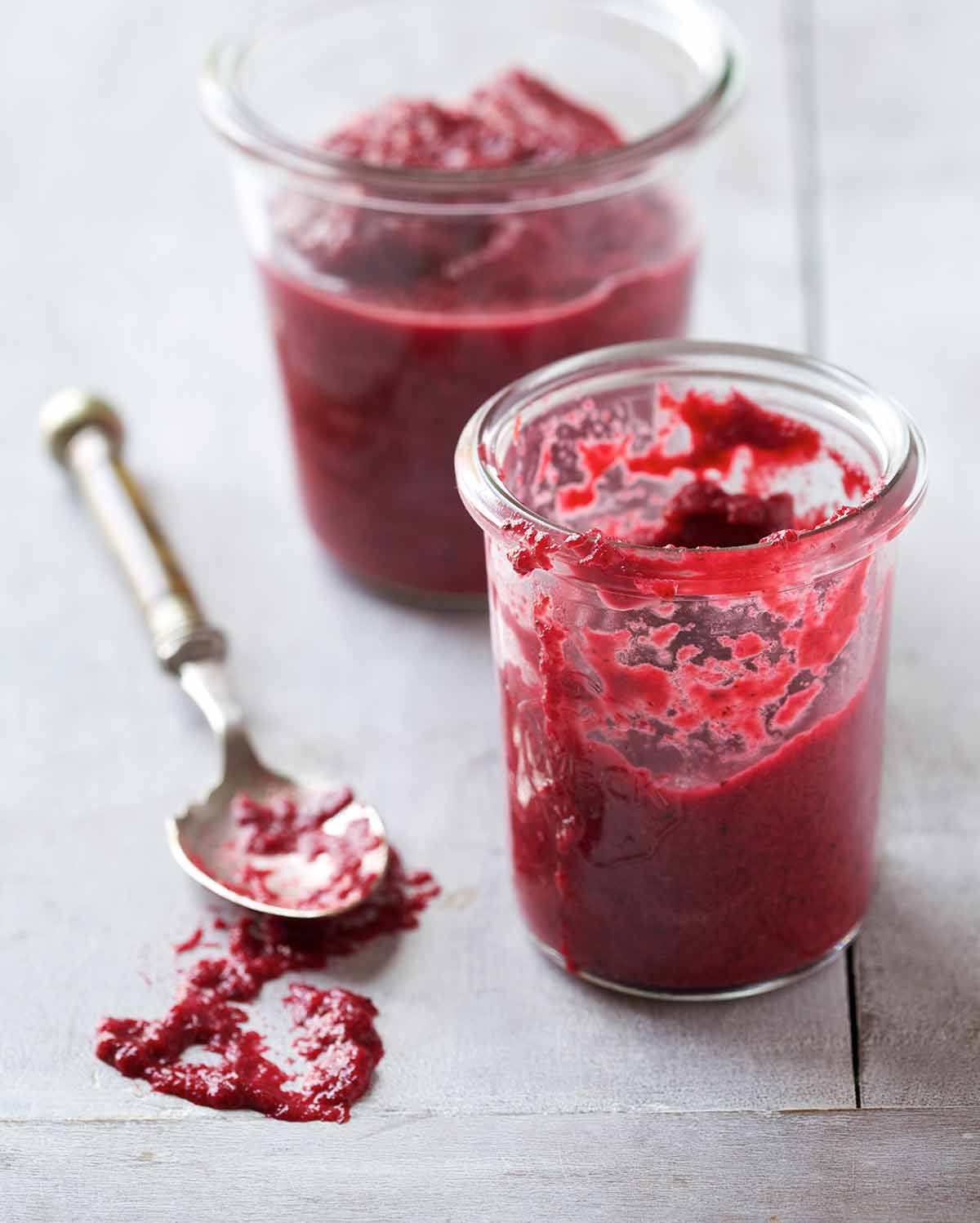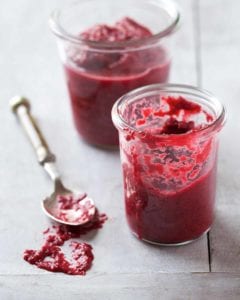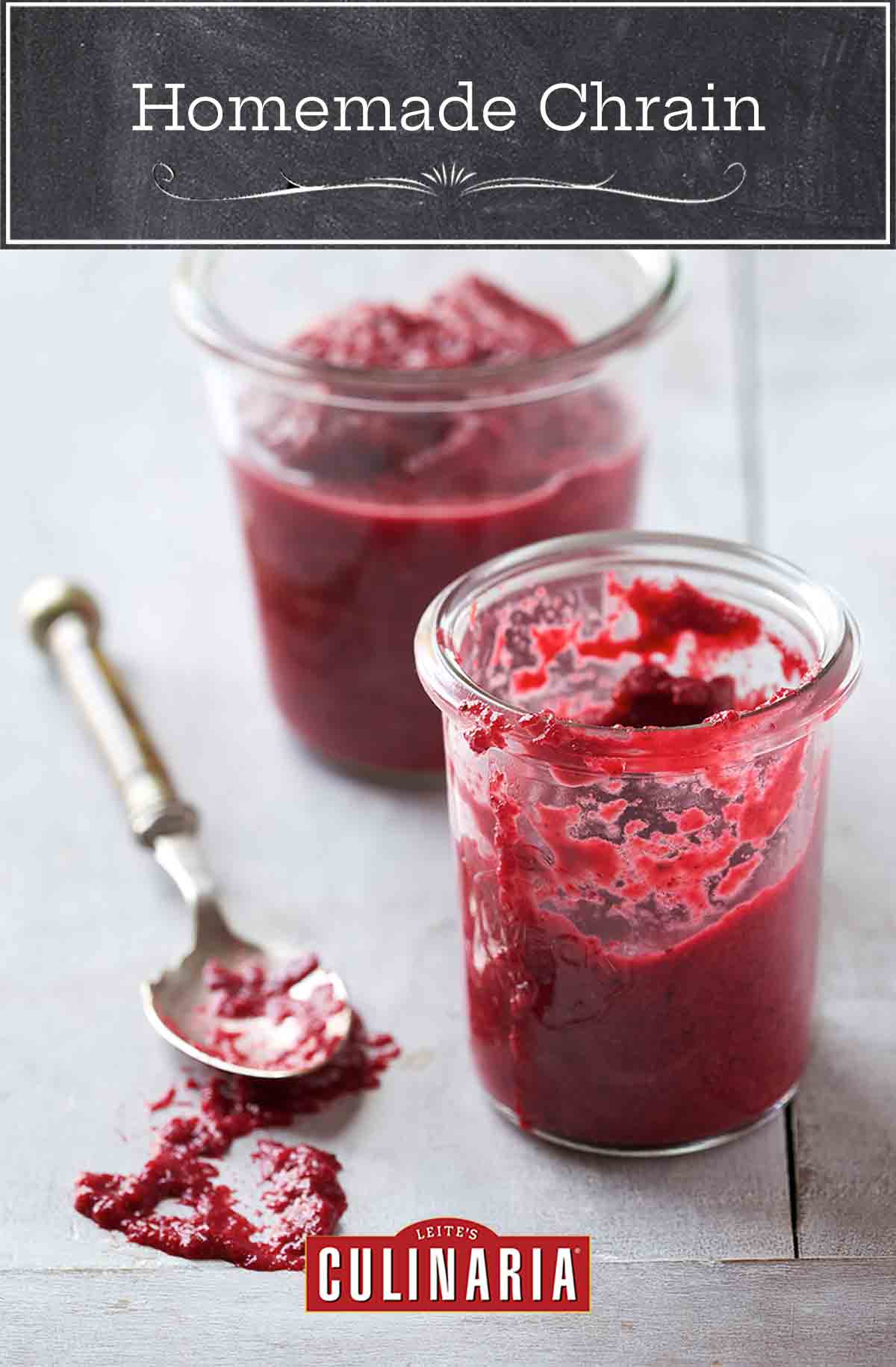
I make chrain for Pesach. It’s easy with a food processor, and the results are glorious. I’ll never buy it again. Double or triple the quantities, if you wish.–Ruth Joseph and Simon Round
Chrain FAQs
What’s chrain, you ask? It’s a heck of a memorable condiment traditionally found on the holiday table come Passover and, in eastern Europe, Easter. Its bracing robustness is most terrific alongside rich dishes such as deviled eggs, gefilte fish, and roasted hen, although it also works admirably as a dip with crudités. Depending on the precise proportion of ingredients that the cook chooses, the condiment’s characteristics are either that of a magenta beet relish spiked with a touch of horseradish or a clear-the-sinuses horseradish paste with a tinge of pink—suit yourself, tweaking and tasting as you make it. Lurking in some of your minds is no doubt the question, Why make it when I can buy it? In response, we have only to quote LC recipe tester and chrain aficionado Sema Stein: “Although a veteran chrain user, this was the first time I have made it myself. The result was delicious with a serious bite to it. I must say, it is the best chrain I have ever had.” Tasting, it seems, is believing.
While this recipe doesn’t result in an enormous amount of chrain, you may have some leftovers. Your best bet is to put it in an airtight container in the fridge – it should last about a week. And yes, you can also freeze it, but be aware it may lose some of its pungency in the process. If you elect to use the freezer option, we recommend spooning your chrain into an ice cube tray, then popping the frozen chrain-sicles into an airtight Ziploc-type bag and storing it in your freezer until you’re ready to use it again.

Homemade Chrain
Ingredients
- 3 medium beets, unpeeled but scrubbed
- One (1- by 3-inch) piece fresh horseradish, peeled and roughly chopped, or more to taste (may substitute prepared horseradish to taste)
- 2 tablespoons cider vinegar (or substitute balsamic vinegar)
- 1 tablespoon olive oil
- 1 1/2 to 2 teaspoons salt
- 1 to 1 1/2 teaspoons granulated sugar
- 1 garlic clove, peeled (optional)
Instructions
- Place the whole, unpeeled beets in a large saucepan and add enough water to cover. Bring to a boil and cook until tender, 30 to 45 minutes.
- Drain the beets and rinse them under cold running water until they’re cool enough to handle. Using your fingertips, slip off the skins. Then coarsely chop the beets. (You should have about 4 cups, give or take a little.)
- Place the chopped beets along with the remaining ingredients in a food processor and process until the desired consistency. (Consider adding the smaller amount of salt and sugar for starters, then toss in more if desired.) Taste and adjust the amount of horseradish accordingly. Cover and refrigerate the chrain for up to 1 week.

Nutrition
Nutrition information is automatically calculated, so should only be used as an approximation.
Recipe Testers’ Reviews
Though a veteran chrain user, this was the first time I’ve made it myself. The result was delicious, with a serious bite to it. I must say, it’s the best chrain I’ve ever had and I won’t be buying it again.
The end result was a beet paste with very small chips of visible white horseradish. I processed the mixture for what seemed like a long time, but wasn’t able to reduce the horseradish root to a paste. I stopped processing due to concern that the beet would become too mushy and not hold up against the gefilte fish that it was paired with. I used cider vinegar and I’d increase the sugar to 1 1/2 teaspoons and reduce the salt to 1 1/2 teaspoons. I didn’t use the garlic.
The color of this alone makes this a winner. The homemade chrain also clears out the sinuses very efficiently. And it’s delicious in small doses.
The flavor is good, but the consistency is very different than the beet-colored horseradish you get in a jar.
There was an issue with the recipe for me: it called for 3 medium-size beets and a 1-by-3-inch piece of horseradish. I think it had too much beet compared to the amount of horseradish for my taste, but the ratios I used created a very spicy result.
The amount of beet I added gave the chrain a more gelatinous consistency than the grainy horseradish consistency I’m used to. The other recipes I found showed a higher ratio of horseradish to beet. But the flavor was good. I used cider vinegar, which imparted the right flavor. No need for the sugar, though, unless spicy isn’t what you want.
This homemade chrain is an easy recipe which has multitude of applications. Starting as a humble dip, it could easily be a condiment or stirred into some soups or stews or added to hummus or just eaten by itself with some fresh pita or naan bread. I used about 2 tablespoons prepared horseradish as fresh was not available to me. Personally, I would add a little more horseradish and a splash of lemon next time I make this.
I’ve always purchased red horseradish to use alongside gefilte fish, but never considered making it until I saw this recipe. Armed with a very fresh and aromatic horseradish root that I purchased at the greenmarket, I headed to my kitchen, got the food processor out, and put the beets on to boil.
After reading some of the comments I opted to use a larger piece of horseradish, about 4 inches long. I ended up using about 2 teaspoons salt and 1 1/2 teaspoons sugar along with cider vinegar. I opted to omit the garlic.
The homemade chrain was delicious and intensely hot, though the beets added sweetness as well as turning the dish a magnificent color. I made it two days before Passover and stored it in a glass jar in the refrigerator, and there was no significant loss of intense flavor. (In fact, a week later my remaining chain is still hot and delicious.) This was a perfect addition to my Passover table and an excellent accompaniment to gefilte fish. It’s also a great accompaniment to matzoh, and we even enjoyed adding a bit of it to chicken salad.
The key is definitely a fresh, flavorful horseradish root—the one I purchased at the greenmarket was definitely a superior product to those available at my local supermarket. Also, when opening the food processor, be very careful as the aroma is truly overwhelming. Last, when I work with beets I always cut them on a stack of newsprint to avoid staining my cutting boards and I wear rubber gloves to avoid staining my hands.













Careful with the horseradish. I tried to make horseradish sauce once, from wild roots growing in the garden, and the effect of grating it was like being tear-gassed. No exaggeration – I had to evacuate the kitchen. The grated horseradish itself had no flavour at all – it had all gone into my eyes and up my nose.
Thanks for the tip, Richard. Wild (or homegrown) horseradish can vary incredibly in strength, but it does tend to be very potent in comparison to store-bought.
You need the vinegar to “set” the flavor.
Wear eye coverings as you prepare it.
Thanks, Steve!
No horseradish available here in inland Spain, would wasabi do, tastewise???
Ooooh Richelle, I’d hesitate before using wasabi. It’s similar to horseradish and yet quite different in the particular type of heat that it packs. But I like the way you’re thinking. Can you perhaps find some jarred prepared horseradish and use a spoonful or so of that?
1) Amp up the horseradish root! Consider skipping the beets altogether. I have been getting my horseradish from The Pickle Guys on the Lower East Side of Manhattan, where the overwhelming choice is white, not red. Many recipes call for lots of horseradish root, vinegar (to “set” the strong flavor) and very little else.
2) Use the shredder blade of your food processor unless you specifically want the mushier consistency.
3) Yes, the smell WILL overwhelm you. I typically see the guys wearing gas masks when grating in front of the public, but that might just be to “amuse” the crowd. You, the amateur, might want to consider eye protection. They do this all day long. You do not.
Laughs. Fair enough on all of that. Love the gas masks! Appreciate you sharing your insights and experiences, Steve. Stay safe and well.
My cousin Vicki makes the chrain for Passover. Hers rocks, so I never bother to try to make it on my own, but I think I’ll make it for other times during the year. Why not? We adore it! Keeping the recipe…
LL
P.S. Pinned to my Jewish Holidays board.
Lovely, Lori Lynn and thanks for the pin!